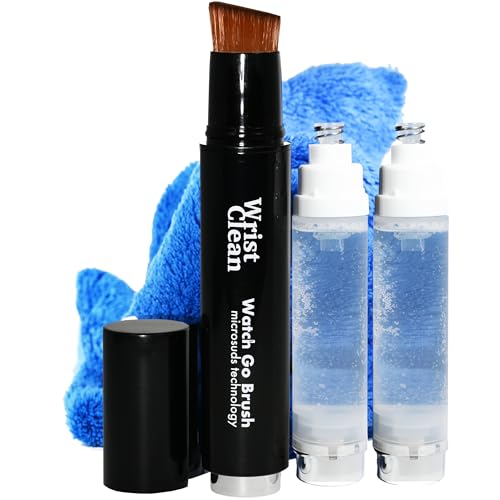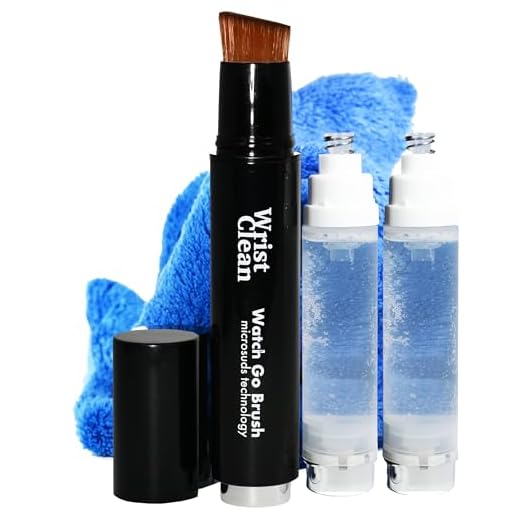Why Caring for Your Leather Strap Matters
A few simple habits can double a leather strap’s lifespan; neglect can make it crack within months. This guide shows six practical, easy steps—cleaning, conditioning, protecting, wearing, storing, repairing—to keep your strap looking great and lasting far longer every day.
What You’ll Need
Soft cloths, small brush, mild leather cleaner or saddle soap, leather conditioner, protector (spray or wax), spring-bar tool or small screwdriver, needle-and-waxed thread (optional). Patience and steady hands.
Clean and Condition Your Leather Watch Strap Like a Pro (Part 1)
Step 1 — Inspect and Detach: Start with a Close Look
Spot hidden damage now so you don’t get surprised later — what should you be worried about?Remove the strap from the watch case using a spring-bar tool or a small screwdriver. Work on a clean, flat surface and keep tiny parts in a dish.
Inspect the leather closely. Look and feel for weak spots; run your thumb along the edges and bend the strap gently where it folds.
Photograph any damage from multiple angles for reference and decide whether to clean, repair, or replace.
Step 2 — Clean Gently: Don’t Overdo It
Yes, you can clean it yourself — but harsh scrubbing is a fast track to ruin. Try this instead.Start with a dry, soft brush or a microfiber cloth to lift dust and grit from folds and stitching. For deeper grime, dampen the cloth slightly with water and a drop of mild leather cleaner or a very diluted saddle soap. Test the solution on a hidden spot (underside or near the buckle) first. Wipe in the direction of the leather grain using light strokes. Avoid scrubbing.
For example, if you spill coffee, dab the spot immediately with a barely damp cloth—don’t rub until the stain spreads.
Clean only when necessary — frequent deep cleaning strips natural oils and accelerates wear.
Step 3 — Condition Correctly: Restore, Don’t Saturate
A little goes a long way — over-conditioning can be worse than none. Learn the ‘goldilocks’ amount.Apply sparingly. Work a pea-sized amount into a soft, lint-free cloth and rub in thin, even layers.
Target crease areas and the inner side that contacts skin. For example, massage the fold near the buckle until it looks evenly damp — not wet.
After cleaning and full drying, apply a suitable leather conditioner to replace lost oils and prevent brittleness. Use a pea-sized amount on a soft cloth and rub in thin, even layers. Focus on areas that crease and the inner side that contacts skin. Allow the conditioner to absorb for several hours, then buff off excess. Condition every 3–6 months, or sooner for dry climates. Avoid petroleum-heavy products on delicate or aniline leather; choose pH-balanced, leather-specific formulations for best results.
Step 4 — Protect from Moisture and Sweat
Water is leather’s enemy, but clever protection can keep your strap safe — what actually works?Protect your strap by applying a breathable leather protector (spray or light wax). Test the product on an inconspicuous spot first to check for color change.
Avoid full waterproofing sealants that stiffen and crack leather. Remove your watch for swimming, showering, or heavy exercise — even a quick dip can stain or warp the lining.
After sweaty wear, wipe the strap with a dry, soft cloth and let it air out flat, away from direct heat. For example, after a sweaty commute, pat it dry and leave the watch on a towel overnight.
Step 5 — Wear and Store Smartly: Small habits, big effects
Rotate, loosen, and breathe — three tiny changes that add months of life to a strap.Don’t overtighten the strap; allow a finger’s width between strap and wrist so leather can flex without constant stress at the holes.
Rotate straps regularly to let leather rest and dry. For example, swap to a nylon or rubber band for workouts and give your leather 24–48 hours to recover after a sweaty commute.
Store straps flat or wrapped loosely around a watch pillow in a cool, dry place away from direct sunlight and heat.
Step 6 — Repair or Replace: Know When to Act
A stitch in time saves nine — and sometimes you should replace, not rescue. How do you decide?Assess the damage: minor issues like loose stitches, small splits, or worn edges can often be repaired. Tighten or replace spring bars and carefully rebore stretched holes with a punch to restore fit.
Attempt simple fixes at home (needle and waxed thread, leather glue, edge dressing) or take the strap to a cobbler for stitch repair and edge finishing. Replace the strap when you see deep cracks through the leather, severe stretching, or persistent, irreparable odor.
Choose quality replacements (full‑grain or top‑grain), match lug width and spring‑bar style, and keep receipts plus service dates for future care.
Keep It Simple, Keep It Beautiful
Follow these six steps regularly and your leather strap will stay handsome and functional far longer; small, consistent care beats occasional deep fixes. Try them, share your results, and inspire others to protect their watch straps—start today right now, please.









Really loved the step-by-step layout — super clear. I especially liked Step 1 about detaching the strap before cleaning. I used to scrub the whole watch and, well, learned the hard way 😅
Question: anyone has a favorite conditioner brand that doesn’t darken light leather? I’m nervous about changing the color.
Good question, Sarah — glad the guide helped! For light leather, look for a neutral, cream-based conditioner labeled for smooth leather. Test on a hidden spot first. Avoid oil-heavy products that can darken or saturate the leather.
I use a small amount of neatsfoot oil sparingly on older straps, but yeah, it darkens. For light straps try a dedicated leather balm with ‘neutral’ or ‘clear’ on the label. Always do the patch test.
Another tip: dab some conditioner onto a cotton swab and apply thinly. Let it absorb overnight rather than saturating. Saves you from surprises.
I tried homemade remedies (olive oil, coconut oil) because I’m cheap 😂 — big mistake. Dark stains and weird smells. The guide’s point about ‘restore, don’t saturate’ is so true. Use the right stuff, folks.
Yep — household oils often contain impurities and can oxidize, causing darkening and odor. Stick to products formulated for leather and apply sparingly.
Pro tip: if you accidentally use a kitchen oil, try wiping with a dry cloth and letting it air (and time) — sometimes it settles, but not guaranteed.
Same here. My DIY phase ended with a strap that looked like it had been dunked in a frying pan. Never again.
If anyone’s on a budget, some leather conditioners are affordable and last a long time. No need for weird kitchen hacks.
Haha, kitchen leather care club. 😂
Not sure why there aren’t more photos in the article showing the inspect/detach steps. A quick diagram of removing spring bars would help beginners. Otherwise, solid tips — saved me from destroying a strap when I first started.
Also: beware cheap spring-bar tools; they can slip and scratch your case!
Agreed on tools. I bought a cheap one once and it bent. Invest in a basic, good-quality spring bar tool.
Thanks for the suggestion, Oliver — a visual guide for spring-bar removal is a great idea. We’ll consider adding diagrams or a short clip to the guide. And yes, a decent tool matters; it reduces slip risk.
Nice guide. I appreciated the ‘Keep It Simple’ line — sometimes people overcomplicate maintenance. Quick note: the bit about sweat protection was spot on. If you live in humidity, consider swapping to a fabric strap for workouts and keep the leather for dress days.
Great approach, Daniel. Rotating straps is one of the best low-effort ways to extend life. And Priya, that’s a smart rotation schedule.
Totally — I rotate mine. Leather for office, nato for gym. Saves so much headache and the leather stays looking newer.
Short and sweet: follow Steps 4 and 5 religiously. Moisture is the enemy. I keep a small pack of silica sachets in my watch box and they’ve helped a ton — straps don’t stink anymore and last longer.
Also, don’t store straps in airtight plastic for long periods.
I refresh mine every few months (dry them in the sun for a bit) — keeps them effective.
Silica sachets are a great idea for storage—thanks for sharing. And yes, avoid airtight storage for long-term leather, it needs to breathe.
Agreed about plastic — had molds once when I stored something in a sealed bin. Lesson learned the hard way.
Do you swap the silica packs periodically? Curious about longevity.
This guide made me actually take the strap off my favorite watch and inspect it for the first time in ages. Found a tiny crack near the buckle — yikes. I cleaned it gently and conditioned, but I’m nervous to wear it for a run. 😂
PS: the bit about not overdoing cleaning is golden. I have a friend who thinks more = better and ruined his strap.
Lol about your friend — I know that guy. 😆 Overcleaning is a real danger.
If it’s just a tiny crack, treat it gentle and avoid heavy sweating until you get it fixed or replaced. Wear it on errands, not workouts.
Good move inspecting it early, Emily. Small cracks can be stabilized with careful conditioning and avoiding moisture. If it gets worse, consider a replacement before it snaps unexpectedly.
Love the repair or replace section. I had a strap start splitting at the lugs and thought I could ‘patch’ it forever — nope. Took it to a cobbler and they fixed the stitching for cheap. Worth the few bucks.
Minor nit: would love a list of signs that mean ‘replace now’ vs ‘repairable.’
Great real-world example, Priya — thanks for sharing. Generally, deep cracks through the leather layers, exposed lining that won’t bond back, or metal fittings failing are signs to replace. Loose stitching, minor edge wear, or a small split at the seam are often repairable.
If the leather is flaking and powdery, that’s past repair in my book. Stitching and edges are fixable though. Cobblers are lifesavers.
Hmm, I think Step 3 could use a little more detail — ‘Condition Correctly’ is good but how long should one wait between conditioning sessions? I conditioned mine last month and it feels okay, but I’m not sure if monthly is overkill.
Also: anyone else hate that sticky feeling some products leave? Ugh.
I condition mine before winter and once after summer. That routine has worked well for me. YMMV depending on sweat and climate.
Thanks for the feedback, James. As a rule of thumb, condition every 3–6 months for daily-worn straps, or less frequently if strap usage is light. If a product leaves a sticky residue, wipe excess off with a soft cloth after allowing it to absorb for 10–15 minutes.
Pro tip: put the strap in a breathable place while it dries after cleaning/conditioning — sunlight can fade it, but a dry airy spot helps it settle without stickiness.
I’m with you on the sticky stuff — switched to a lighter balm and now there’s no tacky feeling. Monthly would be too much for most straps unless you live in very dry conditions.